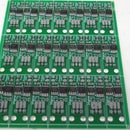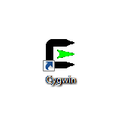Introduction: Assembling a Triple Sensor Board
This instructable shows how to assemble and solder the pieces of a triple sensor board. This triple sensor board will be used in the SALAMANDER Sensors project ( salamandersensors.org ) to sense both light and water flow in local waterways. Each individual triple sensor board will have on it a flow sensor, a photo-sensor, and a thermometer sensor.
Step 1: Preparing for Solder Pasting
The first step in assembling the sensor board is to spread solder paste on the pads where the smaller pieces will be added. In order to do this, we will be using a stencil (shown below).
First tape down a magazine or other scrap surface to work on.
Next, tape down two groups of sensors together in a right angle. These guide boards will help keep in place the group of boards you will be solder pasting.
Slide the sensor boards to be soldered into the corner formed by the taped down guide boards.
* Notice that in the pictures shown, we are solder pasting and assembling a group of 21 sensor boards. At any time, you can break apart the boards if you want to assemble fewer or if you think a step may be easier with the boards apart.
Next, place the stencil on the sensor boards - lining up the holes in the stencil with the corresponding metal pads on the sensor boards. Make sure you have the stencil flipped the correct way so that the smaller pads line up with the staggered holes.
When the stencil is lined up with the sensor boards, tape it down so it won't move around during solder pasting. It is best to tape down two adjacent sides to leave one corner of the stencil able to flip up to allow the sensor boards to slide out after they've been solder pasted (shown in the 5th picture below).
Step 2: Solder Pasting
* Note: gloves should be worn while handling solder paste.
Take the solder paste out of the refrigerator and stir it up to get it a little more workable.
Smear some solder paste onto the stencil in a line (picture 2 below).
Spread the paste across the stencil using an old credit card or a piece of stiff cardboard (picture 3 below).
Make sure that all the silver metal pads are covered by a thin layer of the dull grey solder paste (picture 4 below).
Pull up the free corner on the stencil (picture 5 below) and slide the group of sensor boards out. Make sure that the stencil is lifted high enough not to smear the solder paste on the boards as you pull them out.
Step 3: Placing Small Pieces on Boards
In this step, you will be placing on each board two resistors, one thermometer chip, and one A to D processor chip (the bigger of the two different chips). The best way to stick each piece on the raised solder paste is to place it from directly over top using tweezers. Trying to slide a piece in from the side will move the solder paste out of place. When a piece is in place, gently push straight down on the piece to get it to stick in the paste. The pieces shouldn't slide around on the group of boards as you carry it.
Place the two (per board) resistors first (picture 2 below). When assembling the boards remember it's always easier to place smaller pieces first so the larger pieces aren't already there in your way. Make sure the black side with the number 103 is facing up. Other than that, the resisters are non-polar and can be turned either way.
Next place the thermometer chip and the processor chip (picture 3 below). The thermometer chip (the smaller of the two) should be placed where the pads are closer together. Both chips are polar and so need to be oriented how the picture (3) shows below. There is a small dimple in one corner of the chip designating where pin one is. This dimple needs to be turned toward the three larger pads (away from the resistors). A magnified view of the dimple is shown in the fourth picture below.
Step 4: Hot Plating
Turn the hot plate on and set it to 290 degrees Celsius. If the hot plate doesn't heat evenly across it's surface, you might want to use a metal plate on the hot plate to help distribute the heat. You don't need to wait for the hot plate to heat up before placing your sensor boards on it.
Place your group of boards on the hot plate or on the metal plate on the hot plate. Watch for the solder paste to turn from dull grey (picture 1) to shiny silver (picture 2). If the heating is uneven and only some spots change to silver, you will need to move around the boards on the hot plate. When everything has turned silver (look carefully at the small pads), you can remove the sensor boards from the hot plate. Be careful, the boards will be hot and the hot plate will be very hot so use forceps or a heat resistant pad to remove the group of boards.
Turn off the hot plate. The solder solidifies in a couple seconds but you might want to wait longer for the boards to cool off before you move on to the next step.
*Note: Watch your board while it's on the hot plate. It doesn't take that long and you don't want to leave it on there for too long. Remove it as soon as all the solder turns silver.
Step 5: Adding the Photosensor
A photosensor has two long leads on it. It is non-polar and so it doesn't matter which way it is turned.
Insert the long leads of the photo sensor in the holes marked "Photo cell" as shown in the first picture below.
Bend the long leads so that they hold the photosensor flat against the board while you solder (picture 2).
On the back of the board, solder the base of the leads to the metal ring around the hole (picture 3). Make sure there is enough solder to make contact with the lead and the metal on the board all the way around. The solder should make a cone shape.
Cut the excess leads (picture 4) leaving only the solder cone.
Step 6: Adding the Three-pronged Connector
Before you add the three-pronged and two-pronged connectors, it might be a good idea to break the group of boards into rows (pictured below). Don't break apart the individual sensor boards yet - leaving them in rows makes it easier to keep the two-pronged sensor straight when soldering in the next step.
Place the three-pronged connector into the three holes as shown in picture 2. The piece should snap and hold in place to make soldering easy. Because of this, you can snap a whole row of connectors into place and solder them consecutively.
Turn the boards over and solder the three pins that stick through the board to the metal rings around the holes (picture 3). Just like in the previous step (5), form a cone of solder around the pin. However, there is nothing to trim off after soldering with these pieces.
Step 7: Adding the Two-pronged Flow Sensor Connector
The flow sensor on the triple sensor boards consists of a two-pronged connector as well as the flexible sensor. First we will add the two-pronged connector.
Place the two-pronged connector into the two holes marked "Flow" as shown in the first picture below. The two prongs sticking outward should be parallel to the plane of the board and the prongs should be over top each other in a line perpendicular to the plane of the board. These pieces don't snap into place so it's difficult to get them to stay in line while soldering. You could try a clamp or reverse tweezers (picture 2) to hold the connector straight while you flip the board over and solder the bottom.
Solder the two pins (picture 3) on the under side of the board in the same manner as the three-pronged connector. Again form a cone of solder touching both pin and board all the way around. There is again nothing to trim off after soldering.
Step 8: Adding the Flow Sensor
The flexible part of the flow sensor is fragile and could easily get permanently deflected. Because of this, you might want to wait to add this part until after all the sensor boards have been broken apart and even glued into place wherever they will be used. Also, if you are water proofing the triple sensor boards, you might want to wait to add the flow sensor later so you don't get any of your water-proofing substance on the flow sensor and change its flexibility. If this is the case, make sure and don't cover the two prongs where the flow sensor slides on.
When you do add the flexible flow sensor, simply slide the metal square sleeves over the two prongs as far as they can go (pictured below). Make sure the sensor is oriented like in the picture; the white lettering should be right-side-up and facing inside (toward the photo sensor).
Then solder the prongs to the boxy sleeves on the flow sensor (picture 2). Fill in the gap where you can see the gold prongs in-between the silver sleeve making sure solder touches both parts. Make sure you don't bridge the two prongs with solder. Once soldered, you should no longer be able to slide the flexible flow sensor off the prongs.
The flow sensor is the last part to add - you've now completed assembling the Triple Sensor Board.












